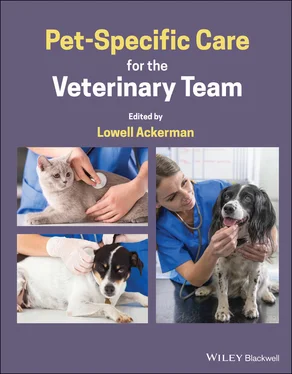Current solutions to the affordability problem primarily include pet health insurance, wellness plans, and financial services (credit cards and payment plans) along with a limited number of privately and publicly funded low‐cost veterinary service programs and practices.
The future of veterinary affordability rests in the hands of the veterinary establishment, where a serious examination of affordability issues is currently under way.
 MISCELLANEOUS
MISCELLANEOUS
Reference
1 1 Volk, J.O. (2011). Executive summary of the Bayer veterinary care usage study. JAVMA 238 (10): 1275–1282.
1 ASPCA press release. Miami‐Dade County Becomes 10th Community in ASPCA Partnership. (2010). www.aspca.org/about‐us/press‐releases/miami‐dade‐county‐becomes‐10th‐community‐aspca‐partnership
2 University of Florida College of Veterinary Medicine press release. New UF and Miami‐Dade County collaboration will help homeless animals. (2016). www.vetmed.ufl.edu/2016/08/18/new‐uf‐and‐miami‐dade‐county‐collaboration‐will‐help‐homeless‐animals
3 Sullivant, A., Mackin, A.J., and Morse, D. (2020). Strategies to improve case outcome when referral is not affordable. J Vet Med Educ 47: 356–364.
2.11 Discounting in Veterinary Practice
Mark J. McGaunn, CPA/PFS, CFP®
McGaunn & Schwadron, CPA’s, LLC, Medfield, MA, USA
 BASICS
BASICS
2.11.1 Summary
Professional service providers have been particularly vexed after the provision of their service with both (i) billing and (ii) collecting from their clients. Service providers, such as veterinarians, who have acquired a great deal of technical skill may not possess the administrative and financial background skills necessary to convey the importance of what they're providing to the actual explanation of value to clients. Veterinarians should not feel that they are alone in this particular skill set as many professional service providers such as attorneys, accountants, financial planners, architects and even physicians, among others, have long been deficient in this learned skill, and they fully recognize the need to acquire those skills. There are whole consulting industries whose sole purpose is to provide professional service providers with the skills and support to actually charge a “full” price without providing discounts, and buoy the self‐worth of the provider.
Discount:A deduction from the usual cost of something typically given for prompt or advanced payment or for a special category of buyers.
 MAIN CONCEPTS
MAIN CONCEPTS
The goal of being paid for professional services is not just to recognize that there needs to be payment for services rendered, but that the service in and of itself is valuable.
Discounts in and of themselves are not a particularly good method of providing clients or patients with a reward for some form of behavior. However, discounts could be allowed to various client segments upon the execution of a set of predetermined criteria.
Without a strategic plan to outline those criteria, the general provision of payment discounts by all sorts of providers and circumstances encountered by patients could potentially lead to a significant loss in gross revenue as well as the continuation of that revenue loss into successive financial periods. Discounts are actually a detractor from a veterinary practice's profitability, as not allowing a discount allows the forgone discount to flow right to the bottom line and increase profitability (except in cases of production‐based pay). But even in a production‐based pay environment, a high percentage of the discount would still flow to the bottom line of the income statement as profit.
Without a strategic plan in place for providing discounts to the patient base, a veterinary practice owner could potentially continue the devaluation of his or her services without the expectation of driving positive client behavior and it could also set the expectation that future continued discounts are an automatic expectation (entitlement) rather than warranted by continued good behavior.
The goal of a sound patient payment discount program should be to:
reward for expected good behavior on the part of compliance
reward the client for achieving strategic financial benchmarks, and
reward intended patient intangibles such as marketing the practice to other potential clients.
If veterinarians realize that part of the delivery of service includes an explanation of the value of that service, generally most clients will accept that delivery of value and the resulting price incurred (see 5.11Discussing Finances for Pet‐Specific Care).
Practitioners with financial knowledge will also be cognisant of the fact that pets are potentially a luxury acquisition. There are many costs post acquisition that are not factored into the original purchase of a pet, including feeding, veterinary care, licensing and registration, daycare, and even dog‐walking services (see 2.9Anticipated Costs of Pet Care). These are not always fully realized at the onset of pet ownership. As record keeping, administration, accounting, and tax reporting are necessary for keeping track of investments, so are the embedded costs of pet ownership noted above. But both investors and pet owners seem to forget that these ancillary expenditures can add up over time.
There are individuals who, whatever the amount of explanation of significant delivery of high‐value services to their pet, will still be expecting a discount purely because they do not want to pay the full price of the service. There really should be no expected discount for the pet owner; discounts should really be infrequent and at the discretion of the veterinary practice.
Typically, unwarranted discounts are unplanned discounts and are generally provided to pet owners after difficult conversations about loss, a poor prognosis or outcome, or just generally poor communication by the veterinarian or staff with a pet owner. At this point, veterinarians may just offer a discount of some magnitude to curtail a difficult conversation or experience.
Some pet owners may prey on the humanistic trait of most veterinary hospitals to emphasize patient care over finances. But, if there is indeed an unplanned event that is precipitated by the veterinarians' or staff's action or inaction, some form of discount may be warranted. However, if there is a “difficult” or strained conversation with this particular pet owner across all patient encounters, maybe this is not the right owner to be seen at this practice. Maybe this particular pet owner should be allowed to pursue other avenues for pet care. This action may have a positive benefit in that staff (including the veterinarian) may not have to dread that client entering the facility and the ensuing tense conversations that follow, the ones that always result in a discount.
In general, the “right” or ideal pet owner is somebody who:
follows all medical direction to the best of their ability
Читать дальше

 MISCELLANEOUS
MISCELLANEOUS BASICS
BASICS MAIN CONCEPTS
MAIN CONCEPTS










